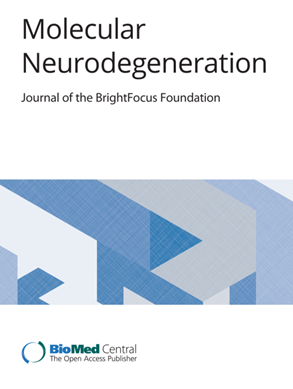阿尔茨海默病小鼠模型脉络膜丛早期转录和细胞异常
IF 17.5
1区 医学
Q1 NEUROSCIENCES
引用次数: 0
摘要
阿尔茨海默病(AD)是一种进行性神经退行性疾病,其特征是淀粉样蛋白-β斑块积累、tau过度磷酸化和神经炎症。脉络膜丛(ChP)作为血-脑脊液-脑屏障,在应激免疫反应和大脑稳态中起着重要作用。然而,ChP对AD进展的细胞和分子作用仍未充分了解。为了阐明AD早期的分子异常,我们从早期Aβ病理的APP/PS1小鼠和窝偶对照中获得了ChP的单细胞转录谱。通过差异表达基因、细胞间通讯和伪时间轨迹分析来鉴定每种细胞类型中发生的转录改变。这些发现随后通过一系列原位和体外试验得到验证。我们在单细胞分辨率下构建了ChP的综合图谱,并在雄性小鼠中鉴定了六种主要的细胞类型和免疫亚群。与野生型(WT)小鼠相比,APP/PS1小鼠的上皮细胞中发现了大多数失调基因,这些基因大多属于线粒体呼吸小体组装、纤毛组织和屏障完整性的下调模块。破坏上皮屏障导致APP/PS1小鼠巨噬细胞迁移抑制因子(MIF)分泌下调,导致巨噬细胞活化,增加对Aβ的吞噬。同时,与WT对照相比,巨噬细胞和其他ChP细胞分泌的配体(如APOE)促进脂质进入室管膜细胞,导致APP/PS1小鼠脑实质中的脂质积累和小胶质细胞的激活。综上所述,这些数据描述了AD小鼠模型中ChP的早期转录和细胞异常,为AD的脑血管病理生物学提供了新的见解。本文章由计算机程序翻译,如有差异,请以英文原文为准。
Early transcriptional and cellular abnormalities in choroid plexus of a mouse model of Alzheimer’s disease
Alzheimer’s disease (AD) is a progressive neurodegenerative disorder characterized by the accumulation of amyloid-β plaques, tau hyperphosphorylation, and neuroinflammation. The choroid plexus (ChP), serving as the blood-cerebrospinal fluid-brain barrier, plays essential roles in immune response to stress and brain homeostasis. However, the cellular and molecular contributions of the ChP to AD progression remain inadequately understood. To elucidate the molecular abnormalities during the early stages of AD, we acquired single-cell transcription profiling of ChP from APP/PS1 mice with early-stage of Aβ pathology and litter-mate controls. The transcriptional alterations that occurred in each cell type were identified by differentially expressed genes, cell–cell communications and pseudotemporal trajectory analysis. The findings were subsequently validated by a series of in situ and in vitro assays. We constructed a comprehensive atlas of ChP at single-cell resolution and identified six major cell types and immune subclusters in male mice. The majority of dysregulated genes were found in the epithelial cells of APP/PS1 mice in comparison to wild-type (WT) mice, and most of these genes belonged to down-regulated module involved in mitochondrial respirasome assembly, cilium organization, and barrier integrity. The disruption of the epithelial barrier resulted in the downregulation of macrophage migration inhibitory factor (MIF) secretion in APP/PS1 mice, leading to macrophage activation and increased phagocytosis of Aβ. Concurrently, ligands (e.g., APOE) secreted by macrophages and other ChP cells facilitated the entry of lipids into ependymal cells, leading to lipid accumulation and the activation of microglia in the brain parenchyma in APP/PS1 mice compared to WT controls. Taken together, these data profiled early transcriptional and cellular abnormalities of ChP within an AD mouse model, providing novel insights of cerebral vasculature into the pathobiology of AD.
求助全文
通过发布文献求助,成功后即可免费获取论文全文。
去求助
来源期刊

Molecular Neurodegeneration
医学-神经科学
CiteScore
23.00
自引率
4.60%
发文量
78
审稿时长
6-12 weeks
期刊介绍:
Molecular Neurodegeneration, an open-access, peer-reviewed journal, comprehensively covers neurodegeneration research at the molecular and cellular levels.
Neurodegenerative diseases, such as Alzheimer's, Parkinson's, Huntington's, and prion diseases, fall under its purview. These disorders, often linked to advanced aging and characterized by varying degrees of dementia, pose a significant public health concern with the growing aging population. Recent strides in understanding the molecular and cellular mechanisms of these neurodegenerative disorders offer valuable insights into their pathogenesis.
 求助内容:
求助内容: 应助结果提醒方式:
应助结果提醒方式:


